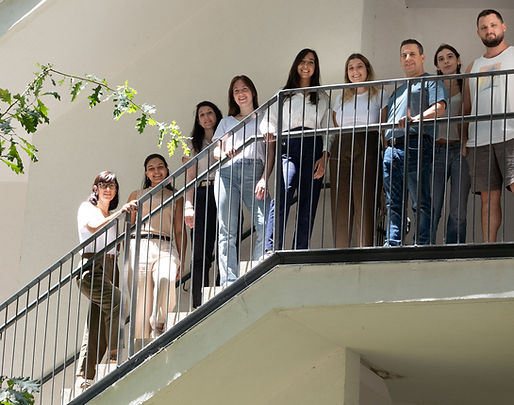
Research
Expression and purification of ubiquitylated proteins from E. coli
Ubiquitylation regulates nearly all cellular pathways, but degradation and deubiquitylation processes make it challenging to isolate ubiquitylated isoforms for detailed biochemical and biophysical studies. Through a synthetic biology approach, we have reconstituted the entire eukaryotic ubiquitylation cascade in E. coli, which lacks deubiquitylases, and ubiquitylation-dependent degradation, allowing for the stable accumulation of ubiquitylated proteins. Utilizing two affinity tags—one on ubiquitin and another on the target of interest—this technique enables efficient purification of the modified target. Our system yields milligram quantities of highly purified ubiquitylated-target with native and stable modification. The system facilitates downstream biochemical and structural studies.
Ubiquin-receptors
Our research focuses on understanding how ubiquitin (Ub) directs a vast array of cellular processes. Ubiquitylation—the attachment of Ub to specific proteins—requires decoding by hundreds of Ub receptors that translate this signal into targeted cellular responses. These Ub receptors utilize Ub-binding domains (UBDs) tethered to response domains, thereby exerting their functional role upon the ubiquitylated proteins they bind. Interestingly, Ub receptors themselves undergo ubiquitylation, which we propose serves as a regulatory mechanism that inactivates their activity by blocking their UBDs, as illustrated in our research model. Leveraging our bacterial system for ubiquitylated protein purification, we isolated substantial amounts of ubiquitylated Ub receptors suitable for crystallization. Recent crystallographic analysis of a ubiquitylated Ub receptor has offered novel insights into the role of self-ubiquitylation, enriching our understanding of Ub signal regulation
Structural-Based Bioinformatics for Identification of UBDs
We hypothesized that hidden Ub-binding domains (UBDs) may exist within the Protein Data Bank (PDB). To uncover these in silico, we developed a novel structure-based search algorithm. By superimposing UBD complexes from various UBD families, we identified a minimal atomic cluster (highlighted as red and gray mesh balls in E2-25k) that is sufficient for Ub binding. Using this cluster as a signature, we scanned the PDB and observed high scores for known UBDs, alongside unknown potential UBDs such as the ALIX-V domain. Interestingly, ALIX links several critical processes, including apoptosis via ALG-2, ubiquitylated-cargo trafficking at the MVB, cytokinesis, and retrovirus (like HIV) budding. We validated ALIX-V as a bona fide UBD, using Micro Scale Thermophoresis (MST) to quantify binding affinities for both wild-type and mutant ALIX complexes. Functional assays further demonstrated the importance of Ub-binding in retrovirus budding (Keren-Kaplan, Attali et al., EMBO J, 2013). Building on this success, we are applying our algorithm to other protein structures, recently characterizing the Ub-binding sites of the vWA domain of Rpn10 as published in Nature Communications.
Development and Application of the Split-CAT System for Protein-Protein Interaction
and Ubiquitylation Studies
Our research leverages the split-chloramphenicol acetyl transferase (Split-CAT) assay to advance our understanding of protein-protein interactions (PPIs) and ubiquitylation within E. coli. This innovative assay system, built on synthetic biology principles, enables efficient detection of PPIs and ubiquitylation through the assembly of split-CAT fragments, which confer antibiotic resistance upon reconstitution.

Key Publictions
Therapeutic potential of allosteric HECT E3 ligase inhibition
Cell 2025
Structure of ubiquitylated-Rpn10 provides insight into its autoregulation mechanism
Nature
communications 2016
Ubiquitylation‐dependent oligomerization regulates activity of Nedd4 ligases
EMBO J. 2017
A bacterial genetic selection system for ubiquitylation cascade discovery
Nature methods 2016
Split Chloramphenicol Acetyl-Transferase Assay Reveals Self-Ubiquitylation-Dependent Regulation of UBE3B
JMB 2021
Patents
01.
Chloramphenicol resistant split protein and uses thereof
Gali Prag
US Patent 11,932,846
02.
Systems and method for screening small molecules of interest
Gali Prag
US Patent Application 17/285,133
03.
Bacterial systems for analyzing ubiquitylated polypeptides
Gali Prag
US Patent Application 17/207,943
04.
Bacterial systems for analyzing ubiquitylated polypeptides
Gali Prag
US Patent 10,982,252











